Lenovo IdeaPad 330-15ICH review – gaming device for the average user
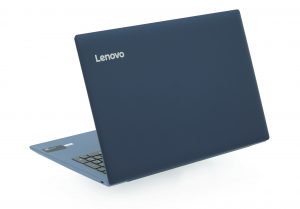 Lenovo IdeaPad 330 15 is a budget mobile assistant which offers you a wide variety of hardware configurations. The unit we got our hands on today is called IdeaPad 330 15-ICH. It features the most powerful hardware offered for this device – an Intel Core i7-8750H processor as well as the budget low-mid level GPU GeForce GTX 1050 with 4GB of memory. However, you can get it with an integrated Intel Graphics HD620 or the energy efficient NVIDIA GeForce MX150.
Lenovo IdeaPad 330 15 is a budget mobile assistant which offers you a wide variety of hardware configurations. The unit we got our hands on today is called IdeaPad 330 15-ICH. It features the most powerful hardware offered for this device – an Intel Core i7-8750H processor as well as the budget low-mid level GPU GeForce GTX 1050 with 4GB of memory. However, you can get it with an integrated Intel Graphics HD620 or the energy efficient NVIDIA GeForce MX150.
It is one of the cheapest devices to feature such hardware inside. Of course, in order to cut the costs, Lenovo had to sacrifice some features. Probably the most noticeable of them are the build quality and use of TN panel. However, in order to check if it is worth to pay a lower price for a gaming device we have to take a deeper look.
You can check the prices and configurations in our Specs System: https://laptopmedia.com/series/lenovo-ideapad-330-15-330-15ich/
Contents
Specs Sheet
Lenovo IdeaPad 330-15ICH technical specifications table
What’s in the box?
In the box of Lenovo Ideapad 330-15ICH, you can find everything expected – the laptop, some paperwork, and a 135W charging device.
Design and construction
Well, the first place you’ll notice a sacrifice hides in the body. The main material here is plastic, which results in a pretty bendy base and lid part. On the bright side, however, the device keeps its weight on point – 2.2 kg with a profile of 23 mm.
As we said, the lid area bends when torsion stress is applied. In addition to that, it looks dated, compared to the latest models. Moreover, there is some jiggling action in the base as well. It is easily noticeable when you apply some stress in the middle of the keyboard.
Speaking of the keyboard, we are talking about a full-size layout with weird “arrow” keys (split up and down arrow) and the keys are clicky and responsive. The touchpad itself feels okay – nothing special here either.
The plastic bottom panel has two large ventilation grills as well as two small ones, where the sound is coming from. The exhausted air is blown right into the hinge cover which may present some difficulties for the cooling.
| Width | Length | Height | Weight | |
|---|---|---|---|---|
| Lenovo IdeaPad 330-15ICH | 378 mm (14.88″) | 260 mm (10.24″) | 22.9 mm (0.90″) | 2.20 kg (4.9 lbs) |
| MSI GL63 8RC | 383 mm (15.08″) | 260 mm (10.24″) | 29 mm (1.14″) (+27%) | 2.20 kg (4.9 lbs) |
Ports
All connectors in the IdeaPad 330 15-ICH is loaded on the left side of the notebook. We find the proprietary power plug, an RJ-45 connector, HDMI port, two USB Type-A 3.0 ports as well as a single USB Type-C 3.1 (Gen. 1) port. In addition to that, you can find an SD card reader and a 3.5 mm audio jack.
Disassembly, upgrade options and maintenance
Since the Lenovo IdeaPad 330 15-ICH doesn’t have a service compartment, you’ll have to remove the whole bottom panel in order to get to the internals. This can be done by unscrewing all 11 of the Phillips head screws.
First things first, we have a fairly inefficient cooling design – two heatpipes cooling the GPU and the CPU simultaneously. Then the heat is relocated to a large heatsink with two fans blowing at it. Here, the problem is that all of the cooling happens on the one side of the device, hence the heat from one of the processors goes to the other one.
Further below this, you can see the RAM DIMM. Some of the memory is upgradable but the rest of it is soldered onto the motherboard. An interesting solution, given that there is a lot of space on the other side of the notebook.
Here you can see the tiny M.2 SSD used in our unit. However, you can still put a full-blown 2280 M.2 drive if you want to.
This device is equipped with a 45Wh battery.
Display quality
Lenovo IdeaPad 330-15ICH is equipped with a Full HD TN panel, model number Innolux N156HGA-EAB. Its diagonal is 15.6″ (39.62 cm), and the resolution – 1920 х 1080. Additionally, the screen ratio is 16:9, the pixel density – 142 ppi, their pitch – 0.18 x 0.18 mm. The screen can be considered Retina when viewed from at least 60 cm (from this distance, the average human eye can’t see the individual pixels).
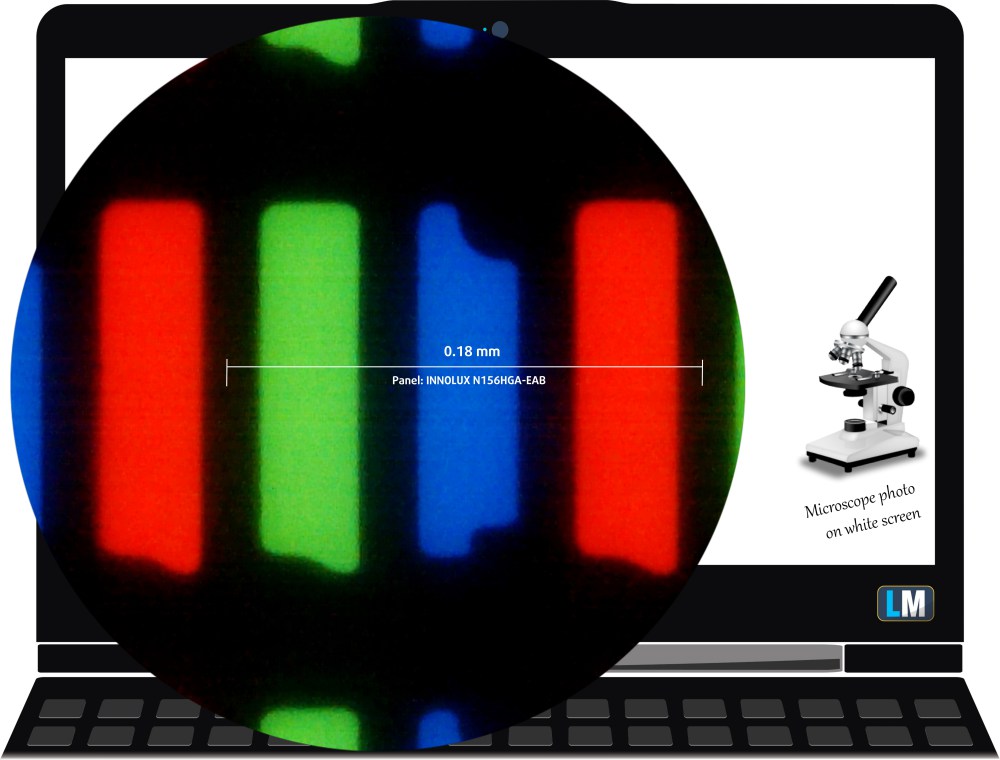
As it is expected from a TN panel, its viewing angles are terrible.

The maximum measured brightness is 204 nits (cd/m2) in the middle of the screen and 195 nits (cd/m2) average across the surface with a maximum deviation of 16%. The Correlated Color Temperature on a white screen and at maximum brightness is 6850K (average) – colder than the 6500K optimum for sRGB. The average color temperature through the grey scale before profiling is 11000K.
In the illustration below you can see how the display performs from uniformity perspective. The illustration below shows how matters are for operational brightness levels (approximately 140 nits) – in this particular case at 90% Brightness (White level = 143 cd/m2, Black level = 0.47 cd/m2).
Values of dE2000 over 4.0 should not occur, and this parameter is one of the first you should check if you intend to use the laptop for color sensitive work (a maximum tolerance of 2.0 ). The contrast ratio is mediocre – 305:1 (255:1 after profiling).
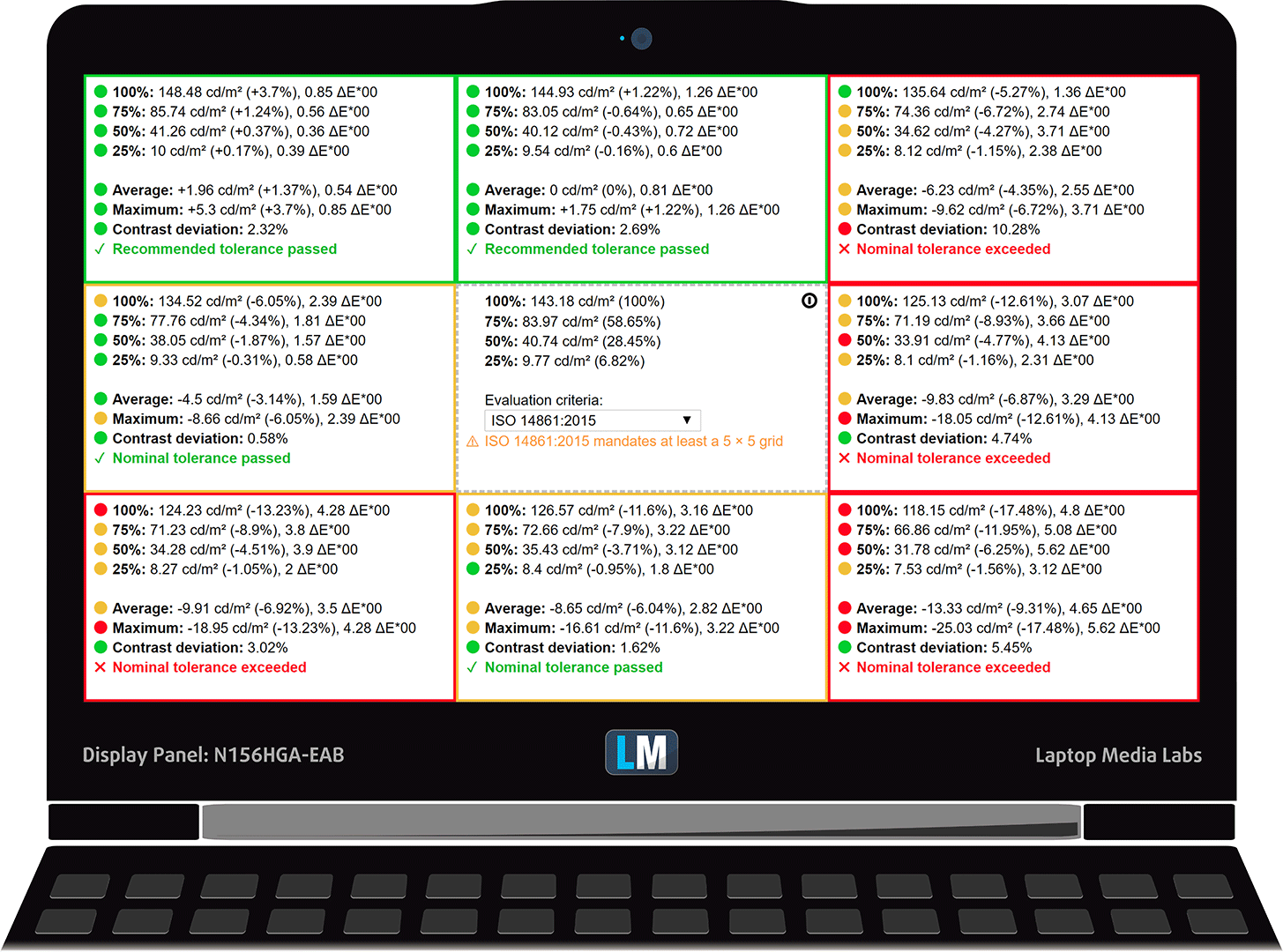
To make sure we are on the same page, we would like to give you a little introduction to the sRGB color gamut and the Adobe RGB. To start, there’s the CIE 1976 Uniform Chromaticity Diagram that represents the visible specter of colors by the human eye, giving you a better perception of the color gamut coverage and the color accuracy.
Inside the black triangle, you will see the standard color gamut (sRGB) that is being used by millions of people in HDTV and on the web. As for the Adobe RGB, this is used in professional cameras, monitors etc for printing. Basically, colors inside the black triangle are used by everyone and this is the essential part of the color quality and color accuracy of a mainstream notebook.
Still, we’ve included other color spaces like the famous DCI-P3 standard used by movie studios, as well as the digital UHD Rec.2020 standard. Rec.2020, however, is still a thing of the future and it’s difficult for today’s displays to cover that well. We’ve also included the so-called Michael Pointer gamut, or Pointer’s gamut, which represents the colors that naturally occur around us every day.
The yellow dotted line shows Lenovo IdeaPad 330-15ICH’s color gamut coverage.
Its display covers only 50% of the sRGB/ITU-R BT.709 (web/HDTV standard) in CIE1976.
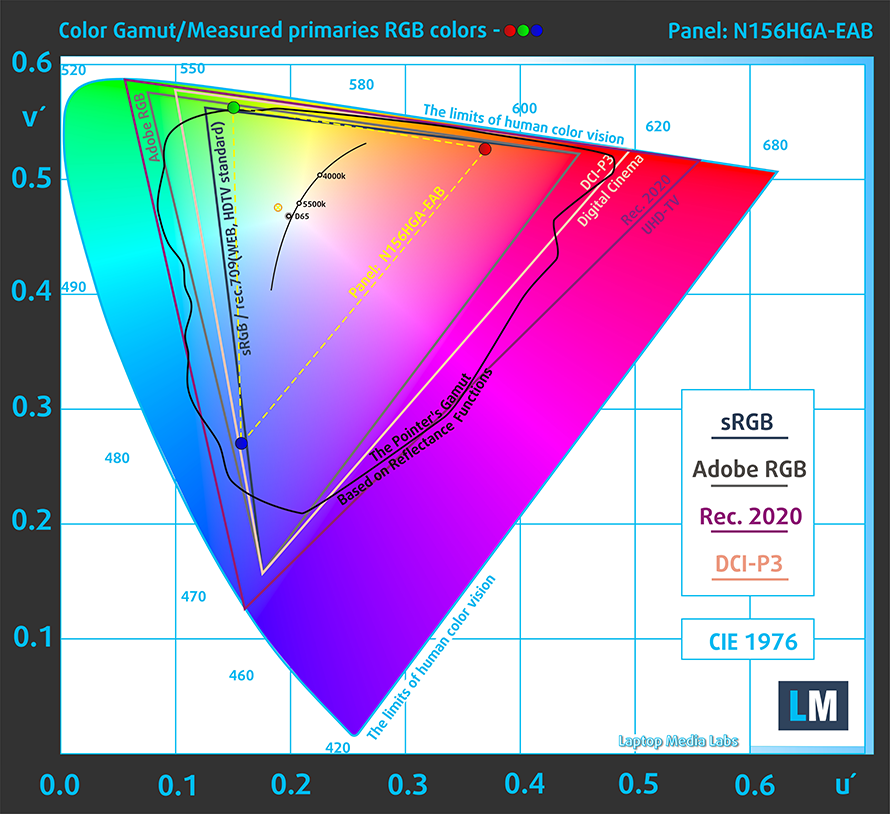
Our “Design and Gaming” profile delivers optimal color temperature (6500K) at 140 cd/m2 luminance and sRGB gamma mode.
We tested the accuracy of the display with 24 commonly used colors like light and dark human skin, blue sky, green grass, orange etc. You can check out the results at factory condition and also, with the “Design and Gaming” profile.
Below you can compare the scores of Lenovo IdeaPad 330-15ICH with the default settings (left), and with the “Gaming and Web design” profile (right).
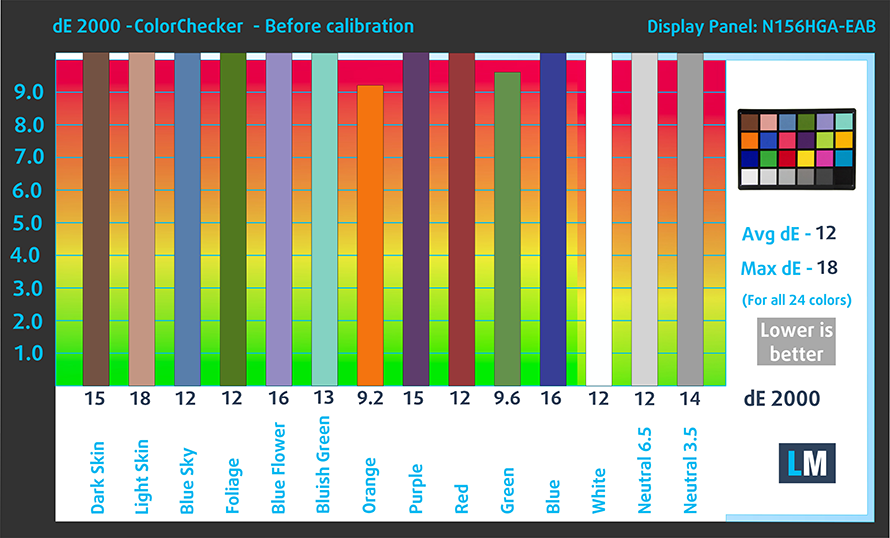
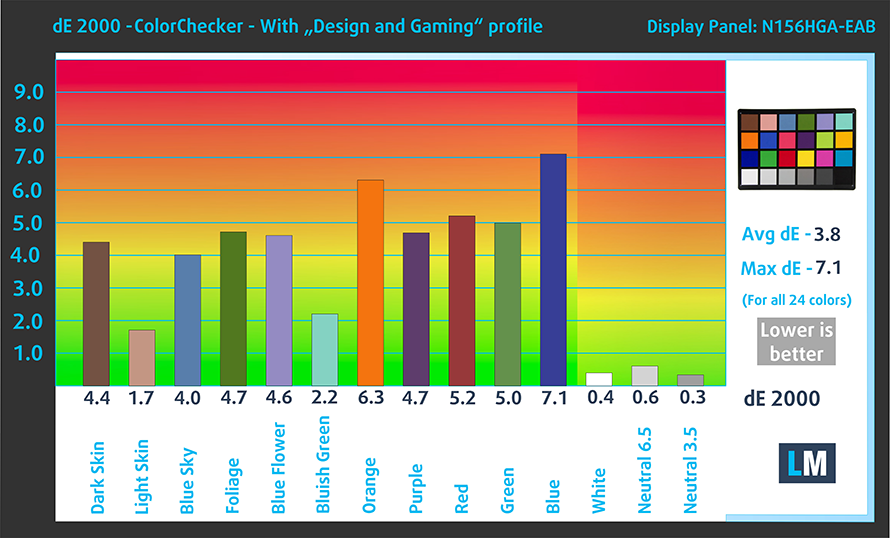
The next figure shows how well the display is able to reproduce really dark parts of an image, which is essential when watching movies or playing games in low ambient light.
The left side of the image represents the display with stock settings, while the right one is with the “Gaming and Web Design” profile activated. On the horizontal axis, you will find the grayscale and on the vertical axis – the luminance of the display. On the two graphs below you can easily check for yourself how your display handles the darkest nuances but keep in mind that this also depends on the settings of your current display, the calibration, the viewing angle, and the surrounding light conditions.
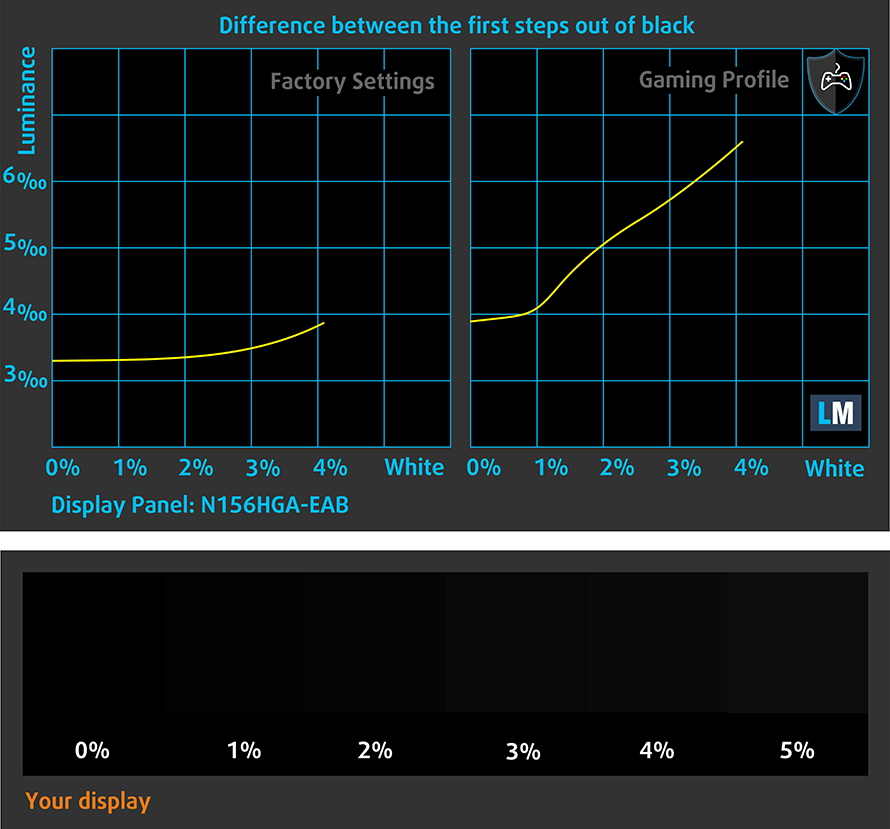
Response time (Gaming capabilities)
We test the reaction time of the pixels with the usual “black-to-white” and “white-to-black” method from 10% to 90% and vice versa.
We recorded Fall Time + Rise Time = 13 ms. This panel is fast.
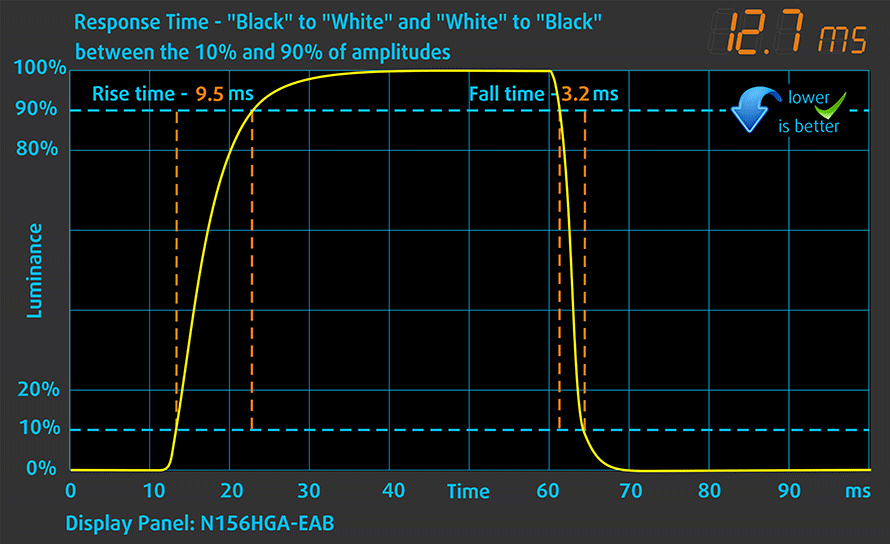
Health impact – PWM / Blue Light
PWM (Screen flickering)
Pulse-width modulation (PWM) is an easy way to control monitor brightness. When you lower the brightness, the light intensity of the backlight is not lowered, but instead turned off and on by the electronics with a frequency indistinguishable to the human eye. In these light impulses, the light/no-light time ratio varies, while brightness remains unchanged, which is harmful to your eyes. You can read more about that in our dedicated article on PWM.
Lenovo IdeaPad 330-15ICH’s display uses PWM to adjust its screen brightness. However, it does so up until 68 nits and the flickering is with a very high frequency. This makes it less harmful and more comfortable in extended periods of use.
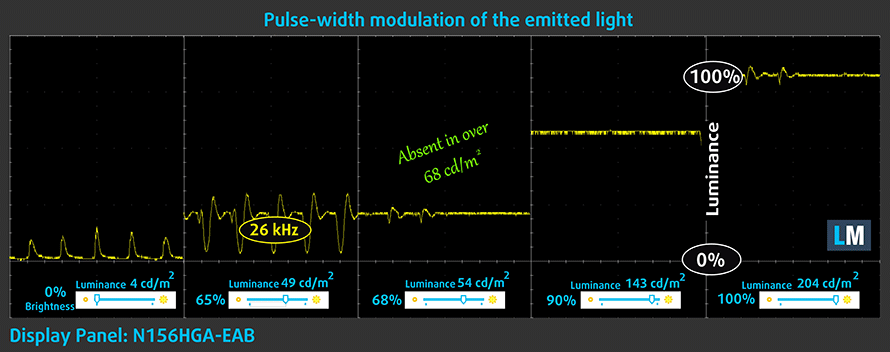
Blue light emissions
Installing our Health-Guard profile not only eliminates PWM but also reduces the harmful Blue Light emissions while keeping the colors of the screen perceptually accurate. If you’re not familiar with the Blue light, the TL;DR version is – emissions that negatively affect your eyes, skin and your whole body. You can find more information about that in our dedicated article on Blue Light.
Conclusions
Lenovo IdeaPad 330-15ICH in this configuration has a budget gaming panel. Its light doesn’t flicker, thus it is not too harmful on the eyes in a wide variety of brightness levels. In addition to that, the panel is fast and has a crisp Full HD resolution. Sadly, it is able to produce only half of the colors found on the Internet and has a very narrow field of view. Moreover, its colors are far off the standard but installing our Gaming and Web design profile greatly improves this.
Buy our profiles
Since our profiles are tailored for each individual display model, this article and its respective profile package are meant for Lenovo IdeaPad 330-15ICH configurations with 15.6″ Innolux N156HGA-EAB, (FHD, 1920 × 1080) IPS.
*Should you have problems with downloading the purchased file, try using a different browser to open the link you’ll receive via e-mail. If the download target is a .php file instead of an archive, change the file extension to .zip or contact us at [email protected].
Read more about the profiles HERE.
In addition to receiving efficient and health-friendly profiles, by buying LaptopMedia's products you also support the development of our labs, where we test devices in order to produce the most objective reviews possible.

Office Work
Office Work should be used mostly by users who spend most of the time looking at pieces of text, tables or just surfing. This profile aims to deliver better distinctness and clarity by keeping a flat gamma curve (2.20), native color temperature and perceptually accurate colors.

Design and Gaming
This profile is aimed at designers who work with colors professionally, and for games and movies as well. Design and Gaming takes display panels to their limits, making them as accurate as possible in the sRGB IEC61966-2-1 standard for Web and HDTV, at white point D65.

Health-Guard
Health-Guard eliminates the harmful Pulse-Width Modulation (PWM) and reduces the negative Blue Light which affects our eyes and body. Since it’s custom tailored for every panel, it manages to keep the colors perceptually accurate. Health-Guard simulates paper so the pressure on the eyes is greatly reduced.
Get all 3 profiles with 33% discount
Sound
Lenovo IdeaPad 330-15ICH has a good quality sound with clear low, mid, and high tones.
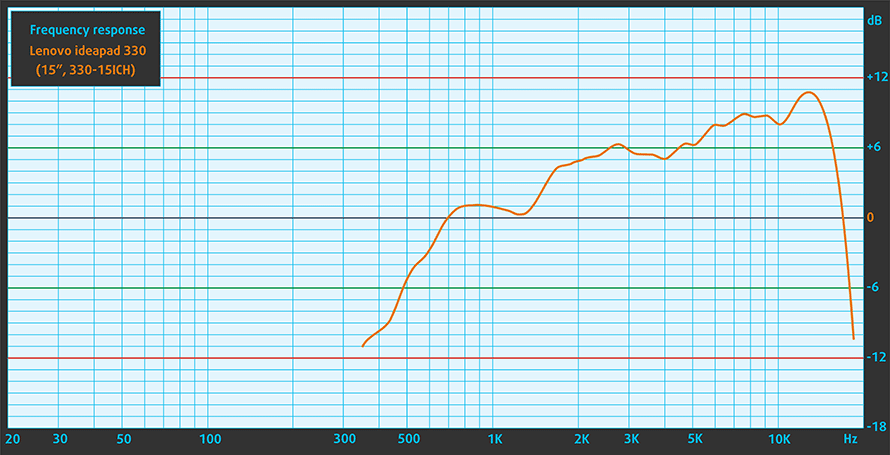
Drivers
If you ever need to reinstall your operating system, you can find all of the software you need on Lenovo’s official web page: https://pcsupport.lenovo.com/bg/en/products/laptops-and-netbooks/300-series/330-15ich
Battery
Now, we conduct the battery tests with Windows Better performance setting turned on, screen brightness adjusted to 120 nits and all other programs turned off except for the one we are testing the notebook with. While 45Wh may indeed sound too small, we were kind of impressed by the battery life of the IdeaPad 330 15-ICH. It got us through solid 5 hours of web browsing and video playback. However, if you are opportunistic enough to game solely on battery power, you’ll get no more than 54 minutes – hardly a single game of DOTA2.
In order to simulate real-life conditions, we used our own script for automatic web browsing through over 70 websites.
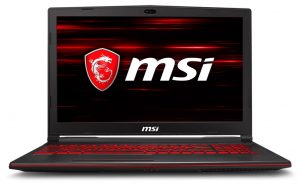

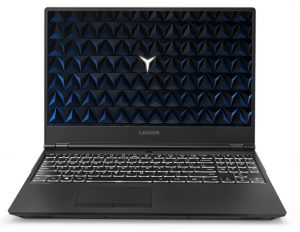
For every test like this, we use the same video in HD.



We use F1 2017’s built-in benchmark on loop in order to simulate real-life gaming.



CPU options
Intel Core i7-8750H is a direct successor to the Core i7-7700HQ. The new Coffee Lake processors feature six physical cores instead of the just four found on the Kaby Lake CPUs. Moreover, the blue company was able to fit the extra two cores on the same 14nm architecture while maintaining a TDP of 45W. In terms of clock speeds, we have a slight drop in the base frequency from 2.8 GHz to 2.2 GHz but the Turbo one is 4.1 GHz (up from 3.8 GHz), whatsoever. This means around 50% better performance on theory and 9 MB of cache (vs 6 MB on Core i7-7700HQ). However, the new Core i7-8750H will be more cooling-dependent, due to the higher clock count and the wide range of Turbo speeds.
On the iGPU end, there are no particular changes as the Core i7-8750H retains the HD Graphics 630 cores with 350 MHz Base frequency and 1100 MHz maximum Dynamic frequency. The only difference is the support of OpenGL 4.5.
Results are from the Cinebench 20 CPU test (the higher the score, the better)
Results are from our Photoshop benchmark test (the lower the score, the better)
Results are from the Fritz chess benchmark (the higher the score, the better)
GPU options
Lenovo IdeaPad 330-15ICH can be bought with a gaming GPU – the GeForce GTX 1050 or with a more energy efficient but still gamable GeForce MX150. However, if you don’t really need a graphics card you can still get it with the integrated Intel Graphics UHD 620.
Results are from the 3DMark: Fire Strike (Graphics) benchmark (higher the score, the better)
Results are from the Unigine Superposition benchmark (higher the score, the better)
Gaming tests
Lenovo IdeaPad 330-15ICH performed on par with other GTX 1050 devices. However, we experienced some drop-outs and system restarts during the gaming tests. It was definitely not because of overheating issues since the device has a pretty conservative cooling policy. This leaves us with potential problems that could be fixed by future drivers.

| Far Cry Primal | Full HD, Normal (Check settings) | Full HD, High (Check settings) | Full HD, Very High (Check settings) |
|---|---|---|---|
| Average | 50 fps | 44 fps | 36 fps |

| Far Cry 5 | Full HD, Normal (Check settings) | Full HD, High (Check settings) | Full HD, Ultra (Check settings) |
|---|---|---|---|
| Average FPS | 41 fps | 37 fps | 34 fps |

| Rise of the Tomb Raider (2016) | Full HD, Lowest (Check settings) | Full HD, Medium (Check settings) | Full HD, Very High (Check settings) |
|---|---|---|---|
| Average FPS | 78 fps | 51 fps | 23 fps |

| TC Rainbow Six Siege | Full HD, Medium (Check settings) | Full HD, High (Check settings) | Full HD, Very High (Check settings) |
|---|---|---|---|
| Average FPS | 94 fps | 75 fps | 70 fps |

| Tom Clancy’s Ghost Recon Wildlands | Full HD, Medium (Check settings) | Full HD, High (Check settings) | Full HD, Very High (Check settings) |
|---|---|---|---|
| Average FPS | 39 fps | 36 fps | 31 fps |
Temperatures and comfort
Max CPU load
In this test we use 100% on the CPU cores, monitoring their frequencies and chip temperature. The first column shows a computer’s reaction to a short load (2-10 seconds), the second column simulates a serious task (between 15 and 30 seconds), and the third column is a good indicator of how good the laptop is for long loads such as video rendering.
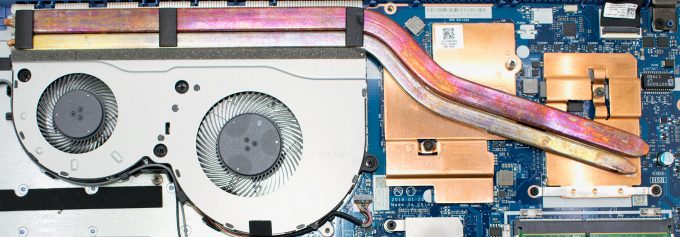
Average core temperature (base frequency + X); CPU temp.
| Intel Core i7-8750H (45W TDP) | 0:02 – 0:10 sec | 0:15 – 0:30 sec | 10:00 – 15:00 min |
|---|---|---|---|
| Lenovo IdeaPad 330-15ICH | 2.20 GHz (B+0%) @ 57°C | 2.21 GHz (B+0%) @ 63°C | 1.86 GHz (B-15%) @ 61°C |
| MSI GL63 8RC | 2.16 GHz (B-2%)@ 56°C | 2.40 GHz (B+9%)@ 62.5°C | 2.47 GHz (B+12%)@ 79°C |
Weirdly enough, we achieved super low temperatures and equally low clock speeds in this test. Hence, low scores in the synthetic benchmarks. It can easily be our worst Core i7-8750H contender. However, Lenovo might address this issue in a future firmware update.
Real gameplay
| GPU frequency/ Core temp (after 2 min) | GPU frequency/ Core temp (after 30 min) | |
|---|---|---|
| Lenovo IdeaPad 330-15ICH | 1718 MHz @ 65°C | 1643 MHz @ 65°C |
| MSI GL63 8RC (GTX 1050) | 1658 MHz @ 65°C | 1645 MHz @ 69°C |
Despite the bad results in the CPU tests, the GPU handled the torture amazingly. It was able to achieve a slightly higher frequency of the chip at the beginning of the test and it finished at the same clock speed and lower temperature than a proven warrior in this game – the MSI GL63 8RC.
Gaming comfort
Considering these results we can draw the conclusion that the body of the laptop won’t heat up excessively. Thankfully, our senses didn’t mislead us – the hottest spot of the IdeaPad 330-15ICH is “T/F/G” junction and reaches 47.9°C, which is perfectly fine.
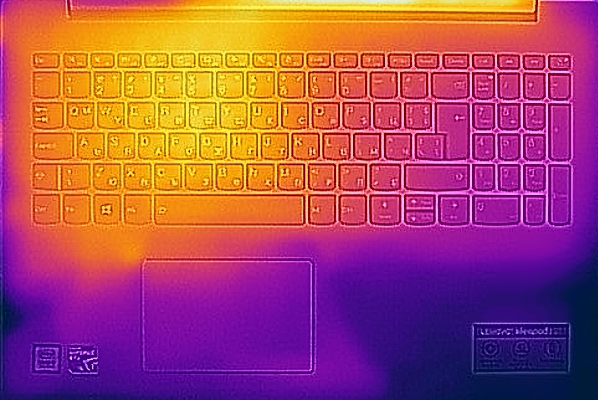
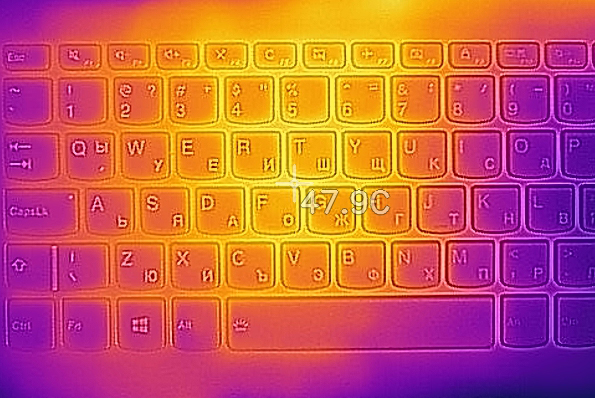
Verdict
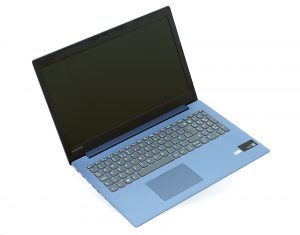 Lenovo IdeaPad 330-15ICH is the pinnacle of budget gaming. The affordable Legion Y530 alternative is neither very well built, nor does it have exceptional performance. However, it isn’t aimed at the pretentious crowd. We doubt that any hardcore gamer is going to buy this product. Quite the contrary, this notebook is the meeting point between gaming on a budget and a personal assistant.
Lenovo IdeaPad 330-15ICH is the pinnacle of budget gaming. The affordable Legion Y530 alternative is neither very well built, nor does it have exceptional performance. However, it isn’t aimed at the pretentious crowd. We doubt that any hardcore gamer is going to buy this product. Quite the contrary, this notebook is the meeting point between gaming on a budget and a personal assistant.
First of all, the IdeaPad 330-15ICH is relatively light, so it is easily portable. Second of all, it has a relatively good battery life, especially if we considered it a gaming device. In addition to that, the TN panel (Innolux N156HGA-EAB) on the model we tested is pretty fast and doesn’t use PWM to adjust screen brightness. Also noteworthy are the reasonably good keyboard and touchpad, despite the lack of illumination.
Sadly, this is everything good about this device. If you get it with the fastest CPU option, brace yourself for a conservative cooling and up to 20% slower performance than other devices on the market. In addition to that, the other significant features of a TN panel are noticeable from the first look.
Actually, the price of a Legion Y530 isn’t even that higher for you to consider this model. Its only advantage over the gaming device is that it looks ordinary. You are definitely going to be incognito with a laptop like the IdeaPad 330-15ICH. All this, with a device that has the same gaming capabilities as MSI GL63 8RC.
Pros
- Adequately priced
- The screen doesn’t use harmful PWM for brightness adjustment (Innolux N156HGA-EAB)
- Good keyboard
Cons
- Bad viewing angles and contrast ratio (Innolux N156HGA-EAB)
- Weird CPU thermal policy
- All-plastic build
- Keyboard lacks backlight
You can check the prices and configurations in our Specs System: https://laptopmedia.com/series/lenovo-ideapad-330-15-330-15ich/
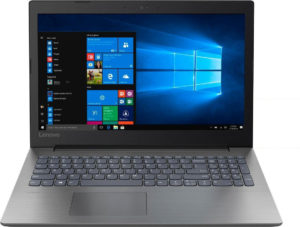
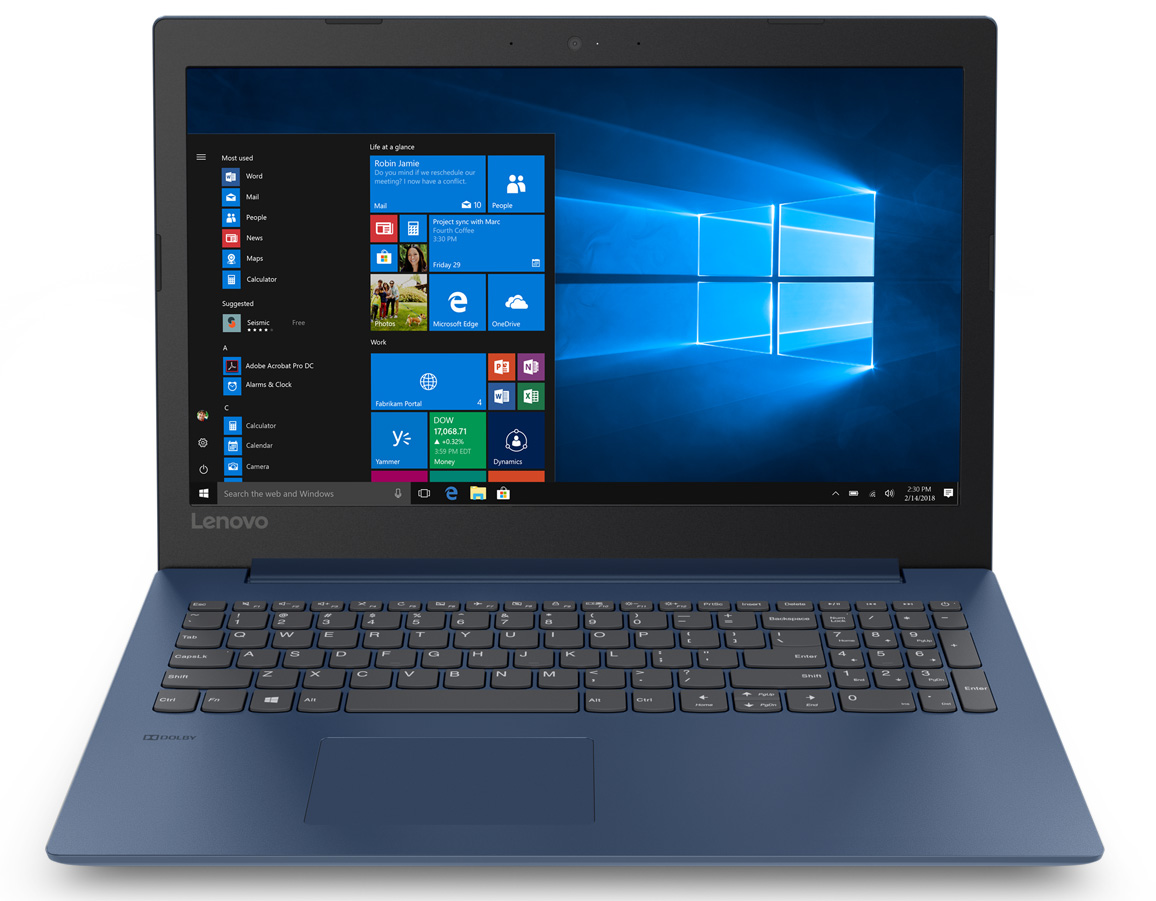
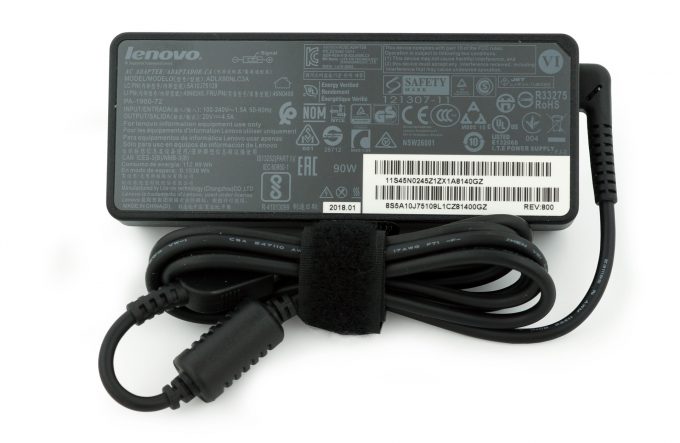
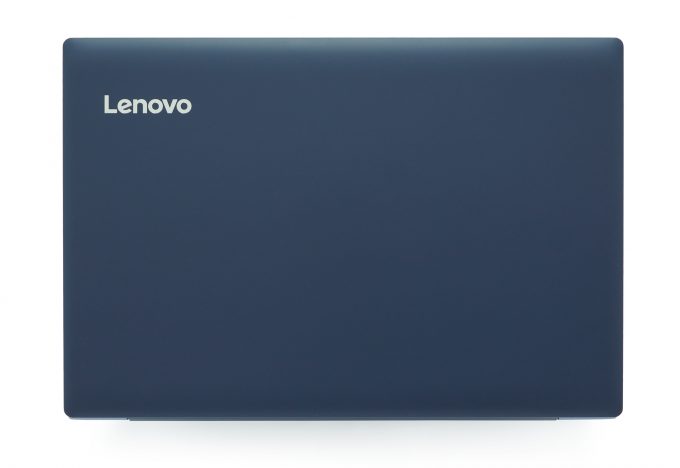
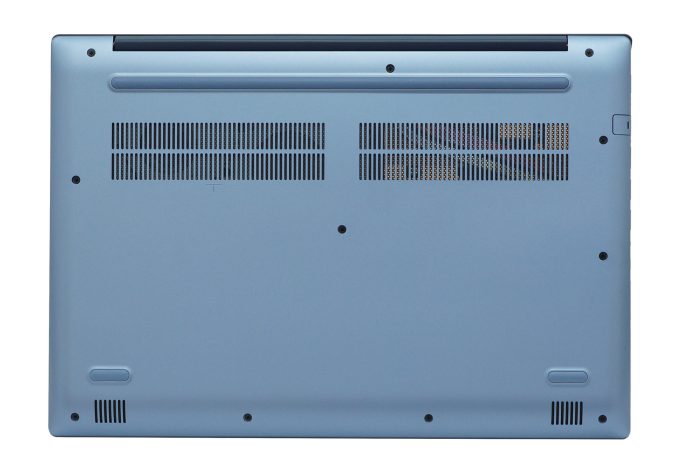
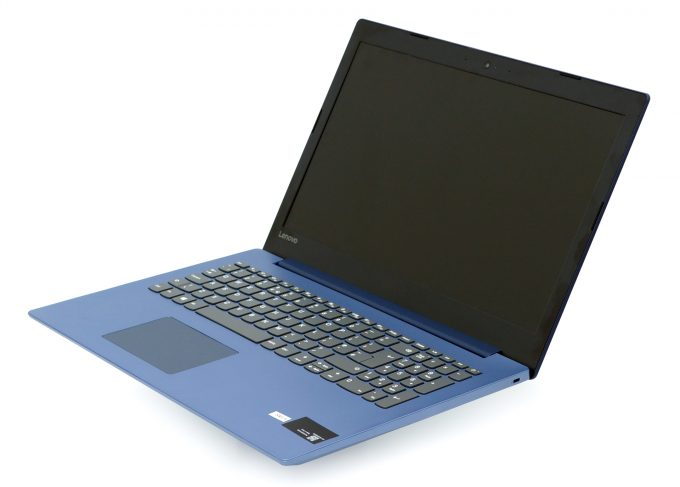
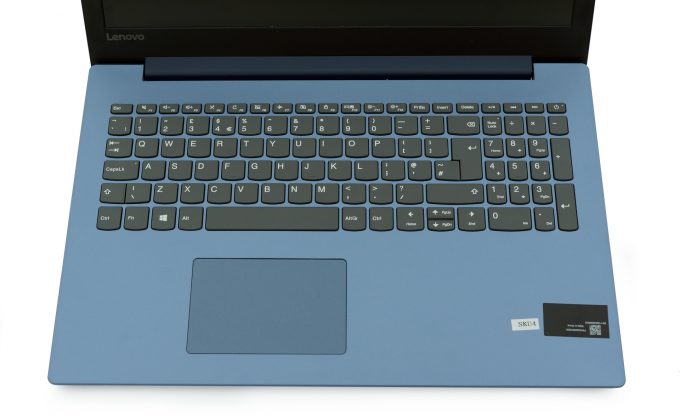
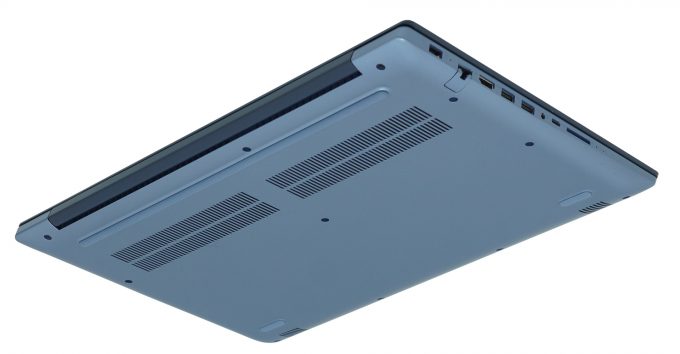


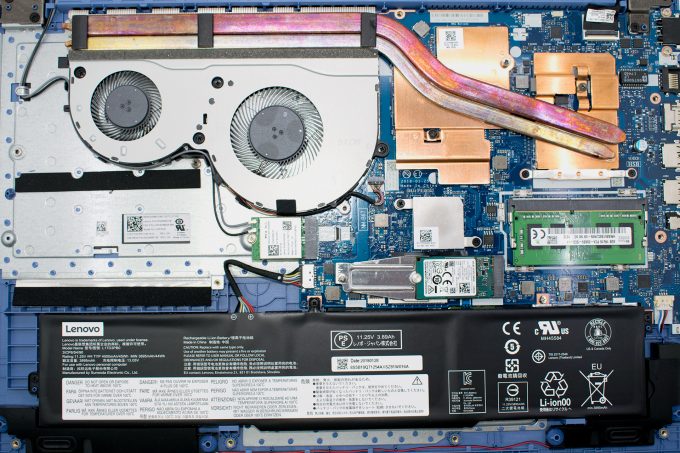

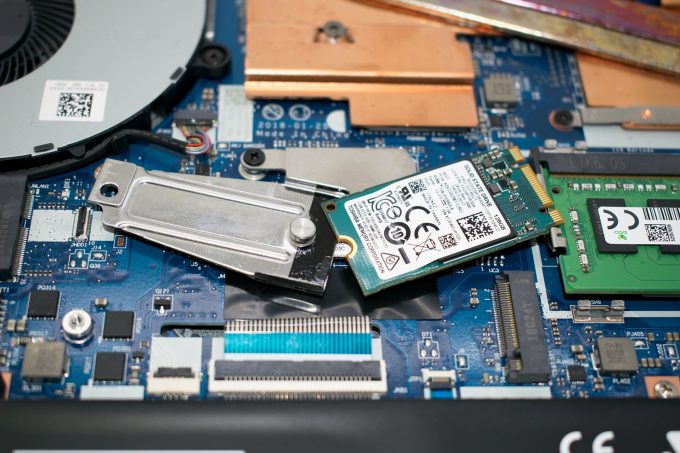


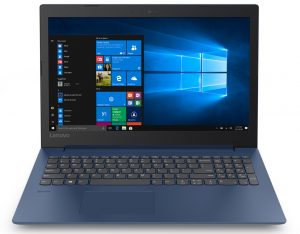



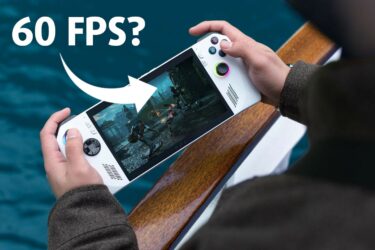
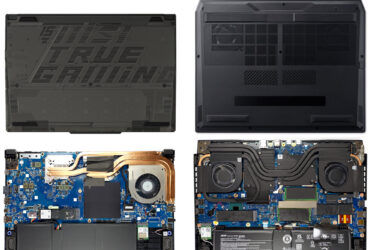
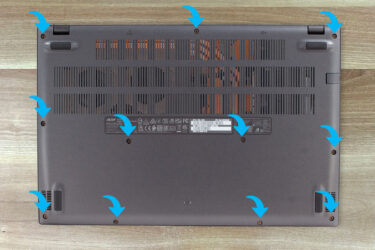
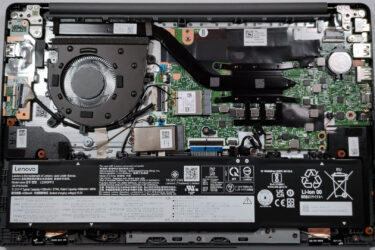
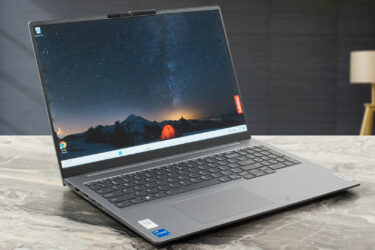
this is uninspiring.
But it is an awesome laptop, like c’mon
Is there aany tool that i can use to help in cooling this device, GPU reache 65 degrees and the cpu cores reach about 50 degrees
Would a cooler be effiecent with this device ?
cooling system is good and don’t have any problem but cpu speed limited with power limitation in fact TDP is limited with cpu speed limited
where are you from mostafa ?are you from iran?
This laptop supports m.2 NVMe ssd?
yes, I have it
i have this laptop and I know support nvme ssd
I have this laptop, I’m looking for upgrade options in terms of storage to it. Is NVME an option? or a 2nd SSD besides the HDD?
sure you can ….I upgraded with adata sx8200 256gb
I have this laptop and I installed “Intel(R) Extreme Tuning Utility” and increase LP1 so cpu speed is higher and temperature is higher too …..so I design a cooling system and solved this problem but I don’t know laptop power supply system can supply this power or damage in long time??????
please help me